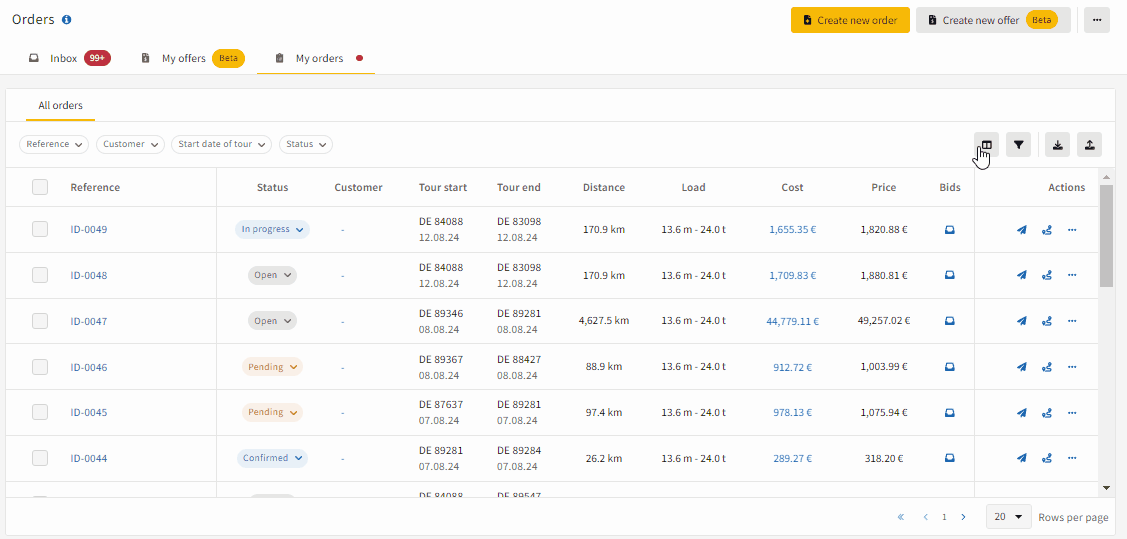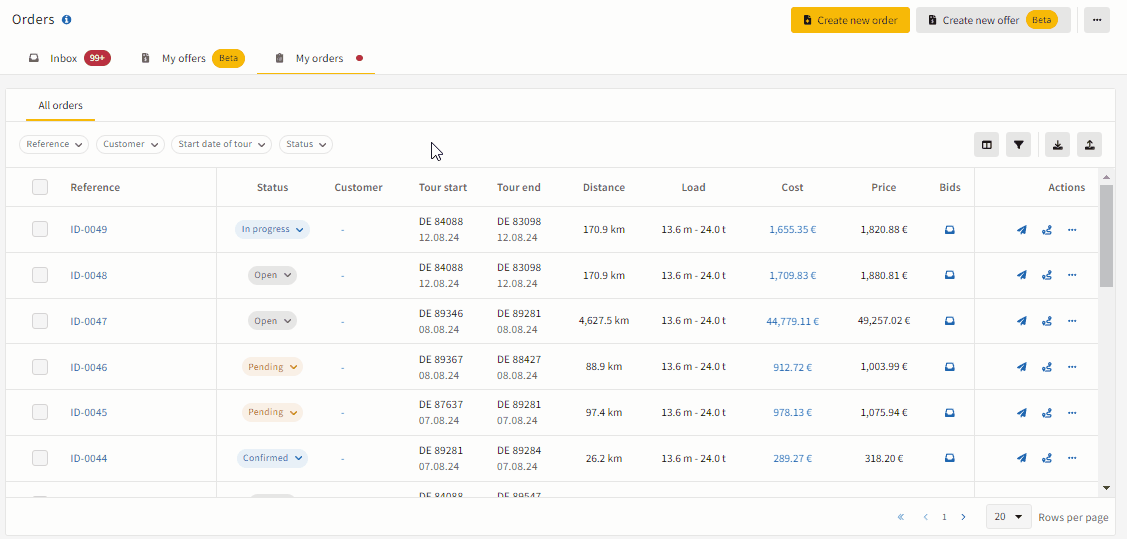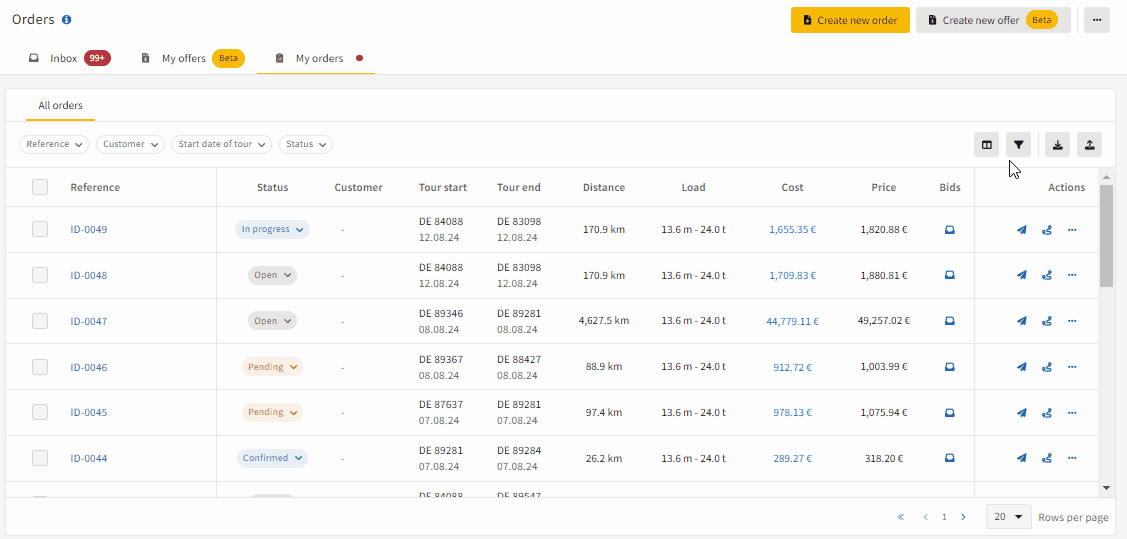Discover how to customize and save specific views of your "My Orders" table, apply filters to quickly find the orders you need, and copy customer information effortlessly. This guide will help you streamline your order management process and improve efficiency.
IMPARGO Knowledge Center
Unleash the full potential of our software with our comprehensive Knowledge Center, offering detailed information on its functionality and features.
Customise "My Orders" Table
1. Choose Columns & Save Views
We’ve reorganized the default columns in the ORDERS module to improve clarity and provide a quick overview of essential order information.
Default Order Columns
- Reference Number
- Status
- Customer
- Tour Start/End
- Distance
- Load
- Cost
- Price
- Vehicle/Trailer/Driver
- Partner
- Fleet
- Bids
- Actions
In addition to the default columns, you can now add even more operational details to your table view:
Additional Columns
- Pallet Spaces – shows how many pallet loading spaces are planned or used for the transport
- Dispatcher – displays the dispatcher assigned to the order
- Alerts – highlights active alerts or issues related to the order
- Template – indicates if the order was created from a template
You can organise the My Orders table exactly the way you need by selecting, hiding, and arranging columns.
How to Customize Your Columns
Step 1: Locate the "Customize Columns" button.
In the → ORDERS module, click on the “Customize Columns” button (often found above or near the orders table).
Step 2: Select your desired columns.
Choose which fields you want displayed, and uncheck any columns you don’t need.
Step 3: Sort the columns.
Next to each chosen column, click and drag the handle on the left of the checkbox to arrange the columns in your preferred order. Changes will update instantly.
Step 4: Use Filters (Optional).
Set the table filters to save them along with the customized table. For example, if you save a filter of a specific customer only the customer will be shown in this saved table view.
Step 5: Use Table Sorting (Optional).
Set the sorting of a column to save it along with the customized table. Simply click on the header of the column to select one of the sortings: A → Z, Z → A or no sort.
Step 6: Save the view.
Once your custom orders table is set up, save your configuration by clicking the "Save View" button next to the columns icon. Name your view and click "Save." Now, you can quickly access your preferred view for your orders table.
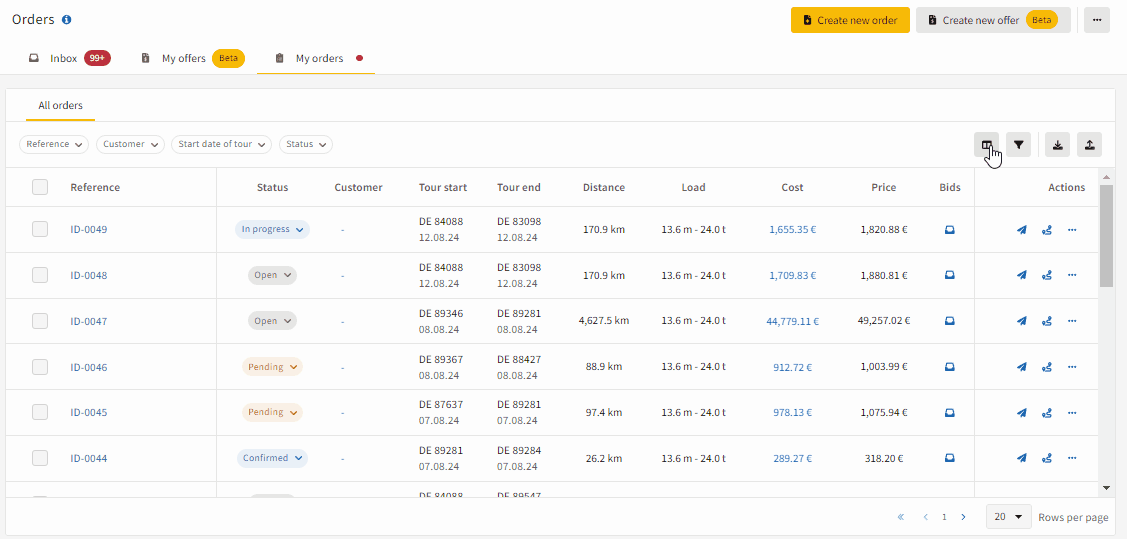
Tip: Use Saved Views to filter and save different column setups for quick access, such as a view focusing on a specific customer or vehicle.
Example Views:
- Active Deliveries Overview
Columns: Reference, Status, Customer, Tour Start, Tour End, Distance, Vehicle, Driver - Financial Summary
Columns: Reference, Status, Customer, Cost, Price, Bids - Fleet Utilization Report
Columns: Reference, Status, Vehicle, Driver, Trailer, Fleet - Daily Operations Dashboard
Columns: Reference, Status, Customer, Tour Start, Tour End, Distance, Load, Vehicle, Driver - Partner & Fleet Overview
Columns: Reference, Status, Partner, Fleet, Vehicle, Driver - Load & Cost Tracking
Columns: Reference, Status, Load, Cost, Price - Tour Management View
Columns: Reference, Status, Customer, Tour Start, Tour End, Distance, Vehicle, Driver, Trailer - Bid Management View
Columns: Reference, Status, Bids, Cost, Price - Driver & Vehicle Assignment
Columns: Reference, Status, Vehicle, Driver, Tour Start, Tour End - Dispatcher Task List
Columns: Reference, Status, Customer, Tour Start, Tour End, Dispatcher
2. Filter the "My Orders" table
Filtering transport orders is straightforward with the IMPARGO filter bar and quick filters. Here’s how to filter your orders:
Step 1: Open Orders module.
Navigate to the Orders Module and select the "My Orders" tab.
Step 2: Open filter settings.
Click on the filter settings icon at the top right of the interface. A submenu with various filter options will appear.
Step 3: Apply filter.
Select your desired filter settings and click "Apply Filter." Your orders table will update instantly.
Step 4: Add favourite filters (Quick Filters).
In the filter drawer, click the star icon next to your preferred filter to mark it as a favourite. A new button will appear above your orders table for easy access to quick filters.
Quick Filter Options:
- Reference #: Filter by the order’s reference number.
- Start Date of Tour: Specify a range for the tour start date.
- Start/End Locations: Filter by countries, zip codes, or other location criteria.
- Customer: Filter by customer.
- Subcontractor: Filter by subcontractor details.
- Driver: Filter by the assigned driver.
- Vehicle: Filter by the assigned vehicle.
- Status: Filter by order status (e.g., pending, confirmed, in progress).
- Pallet Exchange: Filter based on pallet exchange applicability.
- Active and Archived: Distinguish between active and archived orders.
- Custom Fields: Click "More Filters" to access filters for custom fields.
Step 5: Remove filter.
To clear a filter, open the filter submenu and click "Clear Filters", or find it next to the quick filters on the right.
3. Use Advanced Filtering Options
Use Advanced Filters to quickly find the orders that match specific criteria, whether it’s by distance, text, or status.
What Filter Options Are Available?
Use these filters to refine your results based on the data available in your orders:
- Contains: Finds orders that include specific text (e.g. reference number).
- Does not contain: Excludes results with certain text.
- Is empty: Finds orders where a field is blank
- Is not empty: Finds orders with data in a specific field.
- Is: Matches results exactly to the value you specify
- Is not: Excludes results that match a specific value.
Why Use Advanced Filters?
- Flexibility: Create orders without asset details, then assign assets later.
- Collaboration: Multiple statuses support multi-shift planning.
- Efficiency: Updated columns and filters improve how you view and organize your orders.
How to Set Advanced Filters Options
Step 1: Open the "Filters" panel.
In the → ORDERS module, click on Filters.
Step 2: Choose filter options from the following:
- Contains / Does Not Contain: Filter by specific text (e.g., reference number, customer name).
- Is / Is Not: Match an exact value.
- Is Empty / Is Not Empty: Filter by fields that have or do not have data.
Step 3: Apply filters.
After selecting your criteria, the system updates the order list, showing only the matching results.
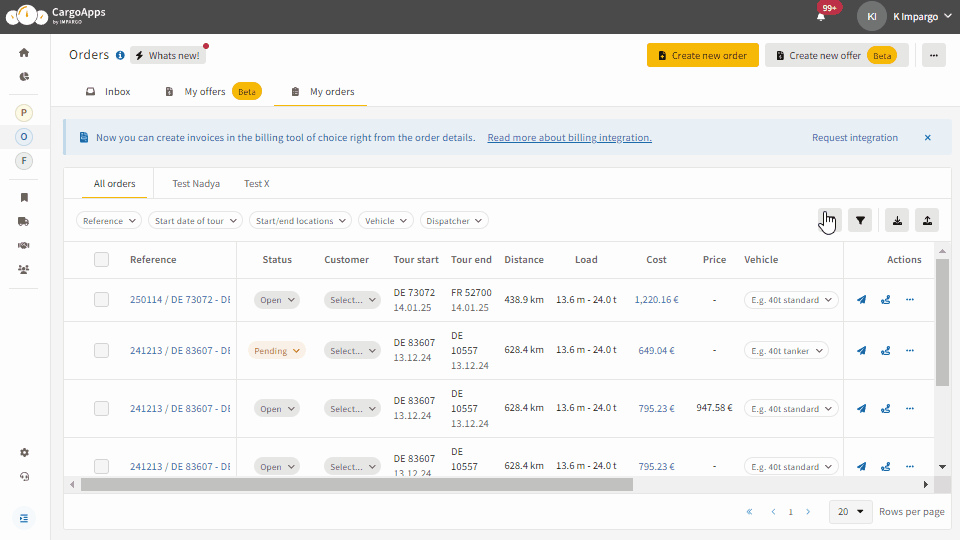
On this page
© IMPARGO 2025, All rights reserved.
